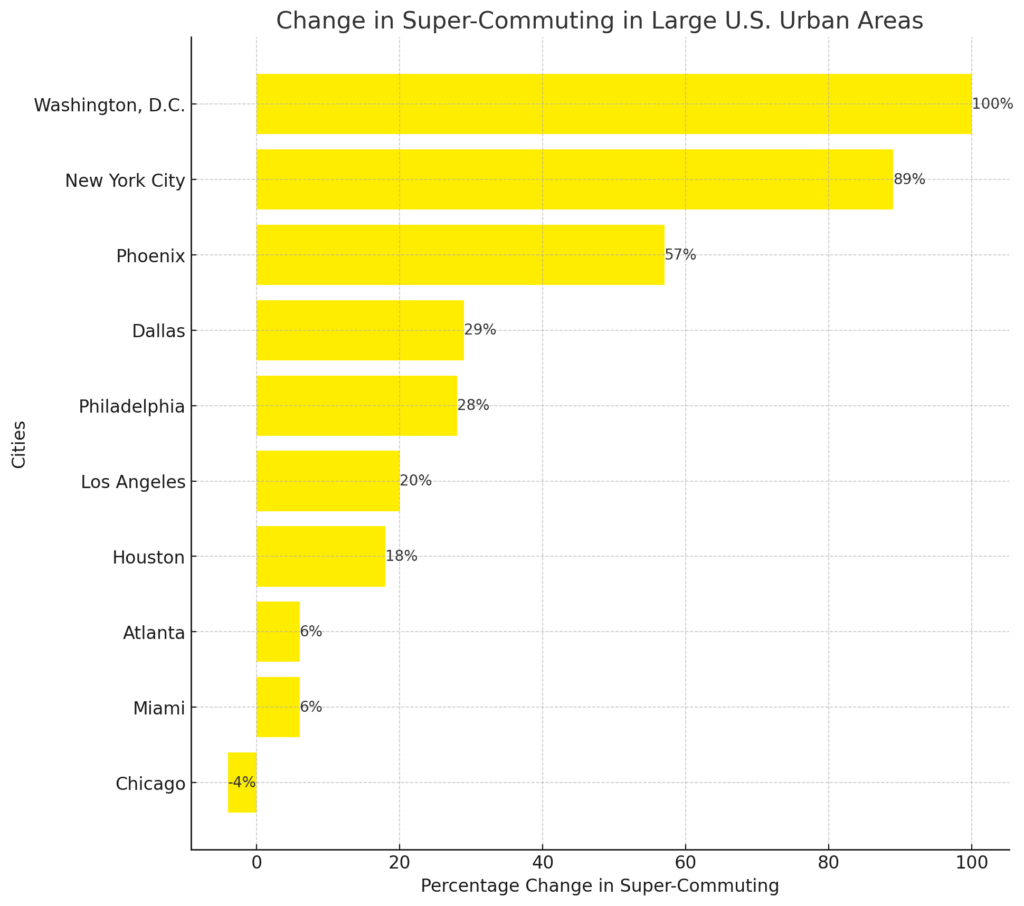The share of Americans who are either taking long commutes or super commuting has grown significantly since pre-pandemic times.
A new study published by Stanford University analyzed car GPS data and found that there has been a surge in long-distance commuting among workers.
The study reveals the share of Americans with commute journeys over 40 miles increased across the 10 largest cities in the United States. For super-commuters, defined as commutes over 75 miles, the share has grown by nearly 33% since 2020.
The researchers, economists Nick Bloom and Alex Finan, revealed that a typical trip for a super-commuter takes 2 hours and 20 minutes and the daily back and forth between work and home is reported to be around 5 hours. While this could be seen as a radical departure from traditional commutes taken in pre-pandemic times, the difference maker here is that super-commuters typically only commute once or twice a week.
Morning commute data on large U.S. urban areas analyzed in the study reveals significant increases were found across the U.S., with the exception being the Chicago metro area:

- New York-Newark-Jersey City, NY-NJ: Increase in super-commuting of 89% in New York City
- Los Angeles-Long Beach-Anaheim, CA: Increase in super-commuting of 20% in Los Angeles
- Chicago-Naperville-Elgin, IL-IN: Reduction in super-commuting of 4% in Chicago
- Dallas-Fort Worth-Arlington, TX: Increase in super-commuting of 29% in Dallas
- Houston-Pasadena-The Woodlands, TX: Increase in super-computing of 18% in Houston
- Atlanta-Sandy Springs-Roswell, GA: Increase in super-commuting of 6% in Atlanta
- Washington-Arlington-Alexandria, D.C.-VA-MD-WV: Increase in super-commuting of 100% in Washington, D.C.
- Philadelphia-Camden-Wilmington, PA-NJ-DE-MD: Increase in super-commuting of 28% in Philadelphia.
- Miami-Fort Lauderdale-Wes Palm Beach, FL: Increase in super-commuting of 6% in Miami.
- Phoenix-Mesa-Chandler, AZ: Increase in super commuting of 57% in Phoenix.
Flexible work arrangements, which allow millions of Americans to participate in either hybrid or remote work environments every week, are also contributing to the rise of longer commutes too.
With commute durations extending, workers are spending a significant portion of their day in transit — which could lead to heightened stress levels, decreased productivity, and a disrupted work-life balance, but again, these are less frequent commutes, on average, than pre-pandemic times.


 Dr. Gleb Tsipursky – The Office Whisperer
Dr. Gleb Tsipursky – The Office Whisperer Nirit Cohen – WorkFutures
Nirit Cohen – WorkFutures Angela Howard – Culture Expert
Angela Howard – Culture Expert Drew Jones – Design & Innovation
Drew Jones – Design & Innovation Jonathan Price – CRE & Flex Expert
Jonathan Price – CRE & Flex Expert











